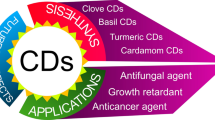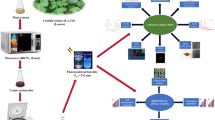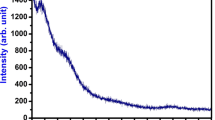Abstract
In the present study, Carbon Quantum Dots (CQDs) were synthesized from Phoenix dactylifera (Date palm fruit) using microwave-assisted pyrolysis and were characterized for its various properties. The synthesized CQD sample exhibited a narrow absorbance peak at 270 nm in UV–Vis spectrum that indicated generation of narrow sized particles. The FTIR analysis of the crude CQDs and dialysed sample revealed the various functional groups involved in the formation of CQDs. TEM data revealed the nature of CQDs to be quasi-spherical and spatially distributed. Biocompatibility of the CQDs was studied using various model systems. CQDs displayed no cytotoxic and anti-clonogenic property when exposed to WRL-68 cell line whereas a slight toxicity was evident in HT1080 post 24 h of incubation suggesting the tremendous potential of the CQDs in the synergistic killing of cancer cells. Phytotoxicity assessment in four different seedlings revealed the non-toxic nature of CQDs. Further these CQDs were found to possess high biocompatibility imposing no inhibition in microbial growth and zilch effect on the development of zebrafish embryos. Thus these CQDs can find immense potential applications in fields of biomedicine as biomolecule detection, drug carriers, fluorescent tracers and in controlling the drug release.








Similar content being viewed by others
Availability of data and material
Yes.
References
Alam AM, Park B, Ghouri ZK, Park M, Kim H (2015) Synthesis of carbon quantum dots from cabbage with down- and up-conversion photoluminescence properties: excellent imaging agent for biomedical applications. Green Chem 17:3791–3797
Arkan E, Barati A, Rahmanpanah M, Hosseinzadeh L, Moradi S, Hajialyani M (2018) Green synthesis of carbon dots derived from walnut oil and an investigation of their cytotoxic and apoptogenic activities toward cancer cells. Adv Pharm Bull 8:149–155
Avdesh A, Chen M, Martin-Iverson MT, Mondal A, Ong D, Rainey-Smith S, Taddei K, Lardelli M, Groth DM, Verdile G, Martins RN (2012) Regular care and maintenance of a zebrafish (Danio rerio) laboratory: an introduction. J Vis Exp 69:e4196
Bajpai VK, Kamle M, Shukla S et al (2018) Prospects of using nanotechnology for food preservation, safety, and security. J Food Drug Anal 26:1201–1214
Baliga MS, Baliga BR, Kandathil SM, Bhat HP, Vayalil PK (2011) A review of the chemistry and pharmacology of the date fruits (Phoenix dactylifera L.). Food Res Int 44:483–491
Bhaisare ML, Abou Talib, Khan MS, Sunil P, Wu HF (2015) Synthesis of fluorescent carbon dots via microwave carbonization of citric acid in presence of tetraoctylammonium ion, and their application to cellular bioimaging. Microchim Acta 182:2173–2181
Braunbeck T, Lammer E (2006) Detailed review paper “fish embryo toxicity assays”. UBA Report Under Contract 20385422:298
Cayuela A, Soriano ML, Carrillo-Carrion C, Valcarcel M (2012) Semiconductor and carbon-based fluorescent nanodots: the need for consistency. Chem Commun 52:1311–1326
Chaudhry Q, Scotter M, Blackburn J et al (2008) Applications and implications of nanotechnologies for the food sector. Food Addit Contam Part A Chem Anal Control Expo Risk Assess 25:241–258
Chen X, Zhang W, Wang Q, Fan J (2014) C8-structured carbon quantum dots: synthesis, blue and green double luminescence, and origins of surface defects. Carbon 79:165–173
Chen W, Hu C, Yang Y, Cui J, Liu Y (2016) Rapid Synthesis of carbon dots by hydrothermal treatment of lignin. Materials 9:184
Cheng J, Flahaut E, Cheng SH (2007) Effect of carbon nanotubes on developing zebrafish (Danio Rerio) embryos. Environ Toxicol Chem 26:708–716
Das A, Snee PT (2016) Synthetic developments of nontoxic quantum dots. ChemPhysChem 17:598–617
De B, Karak N (2013) A green and facile approach for the synthesis of water soluble fluorescent carbon dots from banana juice. RSC Adv 3:8286
Dubey P, Tripathi KM, Sonkar SK (2014) Gram scale synthesis of green fluorescent water-soluble onion-like carbon nanoparticles from camphor and polystyrene foam. RSC Adv 4:5838
Fang Y, Guo S, Li D, Zhu C, Ren W, Dong S, Wang E (2012) Easy synthesis and imaging applications of cross-linked green fluorescent hollow carbon nanoparticles. ACS Nano 6:400–409
Franken NA, Rodermond HM, Stap J, Haveman J, Bree CV (2006) Clonogenic assay of cells in vitro. Nat Protoc 1:2315–2319
Hamad I, AbdElgawad H, Al Jaouni S, Zinta G, Asard H, Hassan S, Selim S (2015) Metabolic analysis of various date palm fruit (Phoenix dactylifera L.) cultivars from saudi arabia to assess their nutritional quality. Molecules 20:13620–13641
Iravani S, Varma R et al (2020) Green synthesis, biomedical and biotechnological applications of carbon and graphene quantum dots. A review. Environ Chem Lett 18:703–727
Kapanen A, Itavaara M (2001) Ecotoxicity tests for compost applications. Ecotoxicol Environ Saf 49:1–16
Khan I, Saeed K, Khan I (2017) Nanoparticles: properties, applications and toxicities. Arab J Chem 12:908–931
Kollur S, Govindaraju S, Chandan S (2019) One-pot synthesis of aqueous carbon quantum dots using bibenzoimidazolyl derivative and their antitumor activity against breast cancer cell lines. Inorg Chem Commun 101:11–15
Kumawat MK, Thakur M, Gurung RB, Srivastava R (2017) Graphene Quantum Dots from Mangifera indica: application in near-infrared bioimaging and intracellular nanothermometry. ACS Sustain Chem Eng 5:1382–1391
Lai C, Hsiao Y, Peng Y, Chou P (2012) Facile synthesis of highly emissive carbon dots from pyrolysis of glycerol; gram scale production of carbon dots/mSiO2 for cell imaging and drug release. J Mater Chem 22:14403
Li W, Zheng Y, Zhang H, Liu Z, Su W, Chen S, Lei B (2016) Phytotoxicity, uptake, and translocation of fluorescent carbon dots in mung bean plants. ACS Appl Mater Interfaces 8:19939–19945
Liang Q, Ma W, Shi Y, Li Z, Yang X (2013) Easy synthesis of highly fluorescent carbon quantum dots from gelatin and their luminescent properties and applications. Carbon 60:421–428
Lim S, Shen W, Gao Z (2015) Carbon quantum dots and their applications. Chem Soc Rev 44:362–381
Linehan K, Doyle H, Mater J (2014) Size controlled synthesis of carbon quantum dots using hydride reducing agents. Chem C 2:6025–6031
Mehta VN, Jha S, Kailasa SK (2014) One-pot green synthesis of carbon dots by using Saccharum officinarum juice for fluorescent imaging of bacteria (Escherichia coli) and yeast (Saccharomyces cerevisiae) cells. Mater Sci Eng, C 38:20–27
Mewada A, Pandey S, Thakur M, Jadhava D, Sharon M (2014) Swarming carbon dots for folic acid mediated delivery of doxorubicin and biological imaging. J Mater Chem B 2:698–705
Mody V, Siwale R, Singh A, Mody HR (2010) Introduction to metallic nanoparticles. J Pharm Bioall Sci 2:282–289
Mosmann T (1983) Rapid colorimetric assay for cellular growth and survival: application to proliferation and cytotoxicity assays. J Immunol Methods 65:55–63
Patel S, Nanda R (2015) Nanotechnology in healthcare: applications and challenges. Med Chem 05:12
Paulo S, Palomares E, Martinez-Ferrero E (2016) Graphene and carbon quantum dot-based materials in photovoltaic devices: from synthesis to applications. Nanomaterials 6:157
Pires NR, Santos CM, Sousa RR, Paula RC, Cunha PL, Feitosa JP (2015) Novel and fast microwave-assisted synthesis of carbon quantum dots from raw cashew gum. J Braz Chem Soc 26:1274–1282
Rafehi H, Orlowski C, Georgiadis GT, Ververis K, El-Osta A, Karagiannis TC (2011) Clonogenic assay: adherent cells. J Vis Exp 49:e2573
Rahmani AH, Aly SM, Ali H, Babiker AY, Srikar S, Khan AA (2014) Therapeutic effects of date fruits (Phoenix dactylifera) in the prevention of diseases via modulation of anti-inflammatory, anti-oxidant and anti-tumour activity. Int J Clin Exp Med 7:483–491
Raj S, Jose S, Sumod US, Sabitha M (2012) Nanotechnology in cosmetics: opportunities and challenges. J Pharm Bioallied Sci 4:186–193
Ray SC, Saha A, Jana NR, Sarkar R (2009) Fluorescent carbon nanoparticles: synthesis, characterization, and bioimaging application. J Phys Chem C 113:18546–18551
Sahu S, Behera B, Maiti TK, Mohapatra S (2012) Simple one-step synthesis of highly luminescent carbon dots from orange juice: application as excellent bio-imaging agents. Chem Commun 48:8835
Samantara AK, Maji S, Ghosh A, Bag B, Dash R, Jena BK (2016) Good’s buffer derived highly emissive carbon quantum dots: excellent biocompatible anticancer drug carrier. J Mater Chem B 4:2412–2420
Singh M, Manikandan S, Kumaraguru A (2011) Nanoparticles: a new technology with wide applications. Res J Nanosci Nanotechnol 1:1–11
Singh R, Kumar R, Singh D, Savu R, Moshkalev S (2019) Progress in microwave-assisted synthesis of quantum dots (graphene/carbon/semiconducting) for bioapplications: a review. Mater Today Chem 12:282–314
Strober W (1997) Trypan Blue Exclusion Test of Cell Viability. Current Protocols in Immunology 12:11–14
Tajik S, Dourandish Z, Zhang K (2020) Carbon and graphene quantum dots: a review on syntheses, characterization, biological and sensing applications for neurotransmitter determination. RSC Adv 10:15406–15429
Tyagi A, Tripathi KM, Singh N, Choudhary S, Gupta RK (2016) Green synthesis of carbon quantum dots from lemon peel waste: applications in sensing and photocatalysis. RSC Adv 6:72423–72432
Wang Y, Hu A (2014) Carbon quantum dots: synthesis, properties and applications. J Mater Chem C 2:6921–6939
Wang Q, Liu X, Zhang L, Lv Y (2012) Microwave-assisted synthesis of carbon nanodots through an eggshell membrane and their fluorescent application. The Analyst 137:5392
Yang X (2012) Clonogenic assay to test cancer therapies. Bio-protocol 2:1–2
Yang Y, Cui J, Zheng M, Hu C, Tan S, Xiao Y, Liu Y (2012) One step synthesis of amino functionalized fluorescent carbon nanoparticles by hydrothermal carbonization of chitosan. Chem Commun 48:380–382
Yang X, Wang Y, Shen X, Su C, Yang J, Piao M, Lin Q (2017) One-step synthesis of photoluminescent carbon dots with excitation-independent emission for selective bioimaging and gene delivery. J Colloid Interface Sci 492:1–7
Zhai X, Zhang P, Liu C, Bai T, Li W, Dai L, Liu W (2012) Highly luminescent carbon nanodots by microwave-assisted pyrolysis. Chem Commun 48:7955
Zhang R, Chen W (2014) Nitrogen-doped carbon quantum dots: facile synthesis and application as a “turn-off” fluorescent probe for detection of Hg2+ ions. Biosens Bioelectron 55:83–90
Zhang X, Cresswell M (2016) Inorganic Controlled Release Technology. Elsevier, Amsterdam, pp 1–16
Zhou M, Zhou Z, Gong A, Zhang Y, Li Q (2015) Synthesis of highly photoluminescent carbon dots via citric acid and Tris for iron(III) ions sensors and bioimaging. Talanta 143:107–113
Zhu S, Song Y, Zhao X, Shao J, Zhang J, Yang B (2015) The photoluminescence mechanism in carbon dots (graphene quantum dots, carbon nanodots, and polymer dots): current state and future perspective. Nano Research 8:355–381
Zulfajri M, Gedda G, Chang CJ, Chang YP, Huang GG (2019) Cranberry beans derived carbon dots as a potential fluorescence sensor for selective detection of fe3 + ions in aqueous solution. ACS Omega 4:15382–15392
Acknowledgements
Authors gratefully acknowledge Centre for Interdisciplinary Research, D. Y. Patil Deemed to be University, Navi Mumbai for providing seeding funds to the present research work (Project No- CIDR/DYPU/Biotech/013). We would also like to thank Mr. Mukeshchand Thakur and Mr. Mukesh Kumawat, IIT- Bombay, for their help and support through characterization studies.
Funding
Seeding funds for the project received from Centre for Interdisciplinary Research, D. Y. Patil Deemed to be University, Navi Mumbai (Project No- CIDR/DYPU/Biotech/013).
Author information
Authors and Affiliations
Contributions
KT: conceptualization, methodology, software, writing- original draft preparation, reviewing and editing. MB: conceptualization, methodology. KSR: investigation, writing- original draft preparation. SS: investigation, writing- original draft preparation.
Corresponding author
Ethics declarations
Conflict of interest
Authors declare no conflict of interest.
Consent for publication
All authors unanimously agree for submission of the manuscript to this journal.
Electronic supplementary material
Below is the link to the electronic supplementary material.
Rights and permissions
About this article
Cite this article
Tungare, K., Bhori, M., Racherla, K.S. et al. Synthesis, characterization and biocompatibility studies of carbon quantum dots from Phoenix dactylifera. 3 Biotech 10, 540 (2020). https://doi.org/10.1007/s13205-020-02518-5
Received:
Accepted:
Published:
DOI: https://doi.org/10.1007/s13205-020-02518-5




